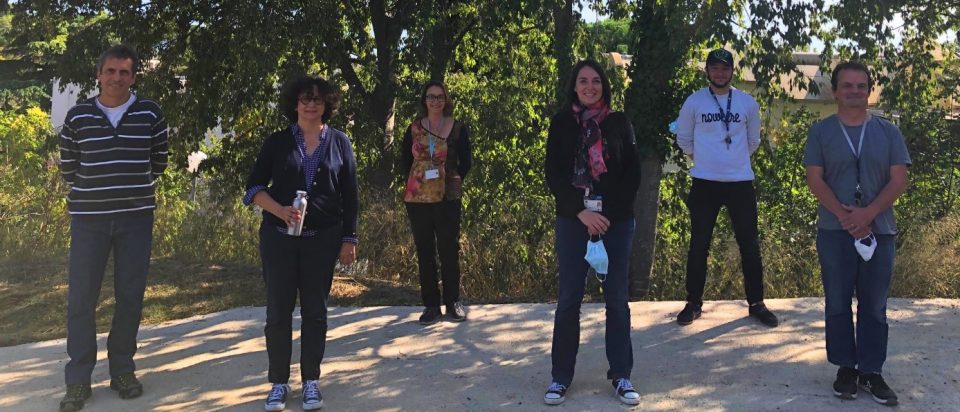Players in the Pathogenesis of the Retroviral Infections
Université de Montpellier1919, route de Mende
34293 Montpellier cedex 5 - Montpellier
Site web - lucile.espert@irim.cnrs.fr - 0434359455
Principal investigator
Lucile Espert

Research themes
Axis 1: Role of autophagy during CD4+ T cells infection by HIV-1 (Véronique Robert-Hebmann, Baptiste Pradel and Lucile Espert).
The type 1 Human Immunodeficiency Virus (HIV-1) infects mainly cells from the immune system expressing the CD4 receptor and the CXCR4 and/or CCR5 co-receptors. Among these cells, the CD4+ T lymphocytes are the major targets of infection. The relationship between HIV-1 and the autophagy process are numerous and complex and seem to depend both on the targeted cell type and the infectious status of the cells (productively infected cells versus uninfected cells). We have shown that the HIV-1 envelope glycoproteins (Env), expressed at the surface of infected cells, induce autophagy in nonproductively infected bystander CD4+ T lymphocytes and that this process leads to their death by apoptosis. Moreover, Env can also induce autophagy at the entry step of HIV-1 into CD4+ T cells, but this process is quickly inhibited, then completely blocked when the infection become productive, suggesting that HIV-1 has developed strategies to control autophagy. In this context, we are now researching, in CD4 T cells, (i) what are the Env-induced signaling pathways leading to autophagy, (ii) the mechanisms linking the Env-induced autophagy to apoptosis in uninfected cells, (iii) the role of autophagy in the early steps of HIV-1 infection (iv) the cellular factors are selectively degraded by Env-induced autophagy in different contexts of infection.
Axis 2: Characterization of the interactions between ASP (HIV-1 antisense protein) and the autophagy pathway (Antoine Gross, Nathalie Chazal and Lucile Espert).
Among the unresolved questions on HIV-1, a particularly intriguing aspect is the case of the asp gene. Indeed, this gene is positioned on the complementary reverse strand of the proviral genome, overlapping of the env gene and allows, thanks to an antisense transcription initiated from the 3’-LTR, the production of the protein ASP (AntiSense Protein). Through evolutionary approaches and the analysis of more than 23,000 virus sequences, we have demonstrated that this 10th HIV gene (M group) appeared concomitantly with the emergence of the AIDS pandemic in the early 20th century. Our work, and that of other teams, has also demonstrated that ASP is well expressed in vivo since an anti-ASP immune response can be detected in HIV-infected patients. Nevertheless, several questions remain and, in particular, it is not understood why the virus has created this gene during its emergence in humans and what advantage ASP could bring to the virus. Our results show that ASP interacts with the autophagic receptor p62/SQSTM1 and that ASP could modulate the autophagic flux. Our project is thus to further characterize the impact of ASP on the cellular response to HIV-1 infection, in particular its role on the autophagic process.
Axis 3: Role of the HIV-1 Tat protein in the control of autophagy and the multiplication of Mycobacterium tuberculosis (Bruno Beaumelle and Lucile Espert).
HIV-1/Mycobacterium tuberculosis (MTB) co-infections are a major public health issue. It has been shown that infection of macrophages by HIV-1, in the absence of other cell types, promotes infection of neighboring (“bystanders”) macrophages by MTB. However, the molecular bases for this facilitating effect are unknown. Both clathrin-mediated endocytosis (CME) and clathrin-independent endocytosis (CIE) are required for phagophore formation and thus for autophagy. The HIV-1 Tat protein is strongly secreted by infected CD4+ T cells and low doses of Tat are known to inhibit PIP2-dependent membrane trafficking. Our data indicate that the secreted Tat promotes the multiplication of MTB in human monocyte-derived primary macrophages. Moreover, Tat affects autophagy in the same cells, suggesting that this viral protein promotes the multiplication of MTB by interfering with endocytosis, and therefore autophagy. The aim of our project is thus to characterize the role of the Tat-dependent autophagy control in the multiplication of MTB.
Publications
Daussy CF, Galais M et al. HIV-1 Env induces pexophagy and an oxidative stress leading to uninfected CD4+ T cell death. Autophagy (2020). In press.
Savoret J et al. A Pilot Study of the Humoral Response Against the AntiSense Protein (ASP) in HIV-1-Infected Patients. Front Microbiol. (2020) Jan 24;11:20.
Alfaisal J, Machado A et al. HIV-1 Vpr inhibits autophagy during the early steps of infection of CD4 T cells. Biol Cell. (2019) Dec;111(12):308-318.
Cassan E et al. Concomitant emergence of the antisense protein gene of HIV-1 and of the pandemic. Proc Natl Acad Sci U S A. (2016) Oct 11;113(41):11537-11542.
Sagnier S, Daussy CF et al. Autophagy Restricts HIV-1 Infection by Selectively Degrading Tat in CD4+ T Lymphocytes. J. Virol 89 (2015), 615-625.
Borel S et al. HIV-1 Vif interacts with LC3 and inhibits autophagy. AIDS, (2015) 29: 275-286.
Espert L et al. Autophagy in Mycobacterium tuberculosis and HIV infections. Front Cell Infect Microbiol. 5 (2015) 49.
Debaisieux S et al. HIV-1 Tat inhibits phagocytosis of opportunistic pathogens by entering macrophages and preventing the recruitment of cdc42 to the phagocytic site. Nature communications. 6 (2015), 6211.
Denizot M et al. HIV-1 gp41 fusogenic function triggers autophagy in uninfected cells. Autophagy. (2008) Nov 16;4(8):998-1008.
Espert L et al. Autophagy is involved in T cell death after binding of HIV-1 envelope proteins to CXCR4. J Clin Invest. (2006) Aug;116(8):2161-72.
Composition de l'équipe
Lucile Espert, CRCN CNRS, lucile.espert@irim.cnrs.fr
Antoine Gross, CRCN CNRS, antoine.gross@irim.cnrs.fr
Nathalie Chazal, MCU, nathalie.chazal@irim.cnrs.fr
Bruno Beaumelle, DR2 CNRS, bruno.beaumelle@irim.cnrs.fr
Véronique Robert-Hebmann, IR2 CNRS, veronique.hebmann@irim.cnrs.fr
Baptiste Pradel, Etudiant en thèse, baptiste.pradel@irim.cnrs.fr